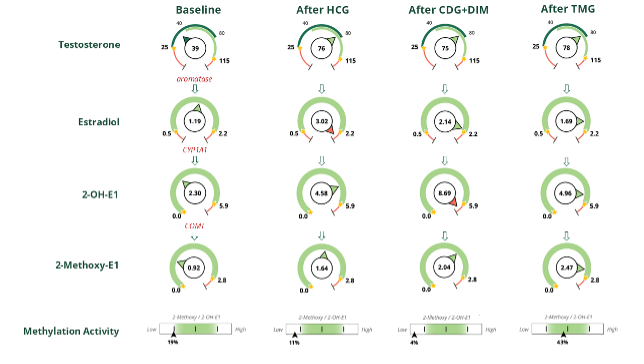The simplified DUTCH Report has arrived, and current DUTCH Providers are eligible for up to 5 DUTCH Complete or DUTCH Plus test kits for 50% off. Learn more and claim this offer!
Using Urine Hormone Testing to Personalize Dietary Supplementation for Hormone Health: A Case Report of a Male with Low Testosterone
Azra Jaferi, PhD
Why is hormone testing useful for personalized dietary supplementation?
People respond to dietary supplements in highly individual ways, influenced by factors such as age, genetics, nutrition, and overall health. This variability from one individual to the next highlights the value of taking a personalized approach to dietary supplementation, where nutrients and doses can be tailored to each person’s unique biology based on their lab testing results. Although personalized approaches are gaining attention in many areas of nutrition and hormone health, testing before and after dietary supplementation is not common in standard clinical practice. A lack of testing can overlook individual differences in responses to supplements, ultimately missing out on opportunities to maximize a supplement’s health benefits and minimize safety-related issues.
Case Example: A Male Patient with Low Testosterone
A recent clinical case report published in Integrative Medicine: A Clinician’s Journal demonstrates how urine hormone testing before and after the addition of supplements can help optimize hormones safely and effectively, using the case of a 47-year-old male patient with suboptimal testosterone levels. Under the care of an integrative provider, the patient used an at-home 4-spot dried urine (DUTCH) collection kit, which allowed convenient urine collection at four times during the day, from morning until bedtime. This offers a broad representation of sex hormone metabolite levels over time. Along with hormone testing, the provider also took into consideration the patient’s previous genetic testing, which showed a variation in the catechol-O-methyltransferase (COMT) gene. This gene normally plays an important role in breaking down and detoxifying catechol estrogens through methylation. People with COMT variations can have reduced methylation activity and an altered response to certain medications and supplements.
Because of the convenience of the at-home DUTCH sampling method, the provider was able to carefully monitor the patient’s hormone metabolite levels before and after each addition of supplements in a step-by-step way. At each step (listed below), multiple urine sex hormone metabolites were measured, including testosterone, estradiol, 2-hydroxyestrone (2-OH-E1), 4-hydroxyestrone (4-OH-E1), 2-methoxyestrone (2-methoxy-E1), 4-hydroxyestradiol (4-OH-E2), and the methoxy/2-OH ratio.
Step 1: Hormone testing was done before any interventions. Testosterone levels in both serum and urine were at the low end of the age-dependent reference range for men.
Step 2: Human chorionic gonadotropin (HCG) was given to raise testosterone, which was effective but also caused an undesired increase in estradiol.
Step 3: To bring estradiol back to normal, the provider added calcium D-glucarate (CDG) and diindolylmethane (DIM) supplements, which corrected the increase, while testosterone levels remained stable.
Step 4: Follow-up testing showed that methylation activity had been progressively decreasing with each addition of supplements. Trimethylglycine (TMG) was then introduced to support the methylation process, followed by chrysin to help keep estradiol in check.
The Patient’s Sex Hormone Testing Results

Shown are dials from the DUTCH Report, illustrating urine values (ng/mg) for testosterone, estradiol, 2-OH-E1, and 2-methoxy-E1, as well as methylation activity as a population percentage. For example, a result of 19% indicates the ratio of 2-methoxy-E1 to 2-OH-E1 in this patient is higher than only 19% of individuals tested using the DUTCH Test. On each dial for testosterone (top row), age-dependent male reference ranges for ages 41-60+ years are shown in dark green and for ages 18-40 years in light green. Arrows in red indicate a result outside of the normal reference range.
Final Outcomes and Clinical Impact
After the test-guided additions of all supplements, the patient’s testosterone and estradiol levels were within the normal range, as was methylation activity. By testing hormone metabolites before and after each supplement, the provider was able to introduce supplements gradually and fine-tune the plan. This stepwise approach supported healthy testosterone levels and estrogen metabolism while accounting for the patient’s unique genetics and methylation needs. Ultimately, the convenience of at-home dried urine sampling facilitated the provider’s ability to repeatedly monitor the safety and efficacy of the supplements and made personalized care for the patient achievable.
Reference
Newman MS, Smeaton J, Jaferi A. Clinical Utility of Urine Hormone Metabolite Testing in Personalized Medicine: A Case Report of a Male Patient with Low Testosterone. Integrative Medicine: A Clinician’s Journal. 2025 Oct;24(5):14-19.
TAGS
Men's Health
General Hormone Health
Testosterone
Estrogen
Laboratory Testing: In-Depth Look at DUTCH Urine Testing